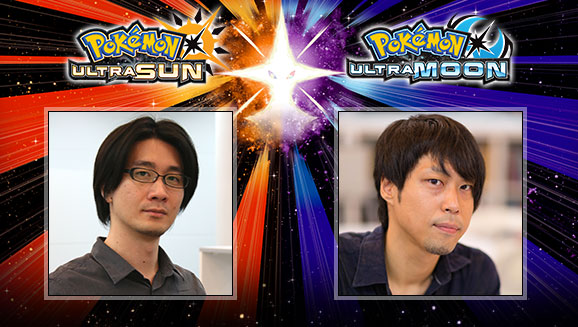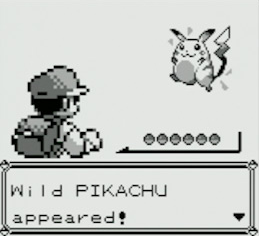An Exclusive Interview with the makers of Pokémon Ultra Sun and Pokémon Ultra Moon!

The following Interview was originally posted on Pokemon.com on November 9th, 2017.
With the impending release of Pokémon Ultra Sun and Pokémon Ultra Moon for the Nintendo 3DS family of systems, we are growing more and more excited about making a return trip to the Alola region. To learn more about our upcoming expedition, we turned to GAME FREAK, the developers of the game, for a little extra insight. We were lucky enough to chat with Kazumasa Iwao, the director of Pokémon Ultra Sun and Pokémon Ultra Moon, and Shigeru Ohmori, the director of Pokémon Sun and Pokémon Moon and current producer of Pokémon Ultra Sun and Pokémon Ultra Moon, who both shared their experiences and thought processes about designing the latest journey into the wonderful world of Pokémon.
Know Your History

Kazumasa Iwao: I first played the Pokémon Red and Pokémon Green games when I was a kid and enjoyed each entry in the series after that. When it became time to look for work, I thought about what I wanted to do, and I knew I wanted create games. So I decided to pursue a career at GAME FREAK, who had created some of the games I really enjoyed.
Shigeru Ohmori: My younger brother was the perfect age for Pokémon Red and Pokémon Green when they came out, and I picked up the games to play together with him. We both got really hooked on the games, and we would battle and trade together, along with his friends.
I knew I wanted to work in video games as a game designer, but there weren't a lot of companies at the time recruiting for that position. However, I found a job posting at GAME FREAK to the position and applied for it.
Pokemon.com: What were the first titles you worked on, and what were your roles on those games?

Mr. Ohmori: I first worked as a game designer on the Pokémon Ruby and Pokémon Sapphire games. I worked primarily on the game environments and communication features. For the television connectivity features, I came up with the initial concepts and worked on them to completion.
The Roots of Pokémon Ultra Sun and Pokémon Ultra Moon
Pokemon.com: These games are a bit of a departure from previous follow-up titles like Pokémon Yellow: Special Pikachu Edition or even Pokémon Black Version 2 and Pokémon White Version 2. What would you call out as the core concept behind Pokémon Ultra Sun and Pokémon Ultra Moon?Mr. Iwao: We came up with the theme of “core” for the development of the game. We decided that we wanted to always focus on the core, or what serves as the base of things, and always focus on what is truly important when developing this game, and that's how we landed on the theme. What is the “core” of Pokémon? What is the “core” or an RPG? What is the “core” of what makes a game? We would constantly ask ourselves these kinds of questions to make sure we were on the right track when coming up with new ideas for the game or making development decisions.

Mr. Iwao: Pokémon Ultra Sun and Pokémon Ultra Moon are really kind of a culmination of our efforts up until now, and we knew when setting out on development that we wanted to do something that features haracters from the other Pokémon games. At first, we were planning to just have some of the bosses from previous games appear in the Battle Agency, but these characters have so much personality, and our story writer felt like he could come up with a story featuring them that could be possible only in Pokémon Ultra Sun and Pokémon Ultra Moon. That's how the post-game Team Rainbow Rocket scenario got its start.
In the game, each of the bosses comes from a world in which they managed to fulfill their dark ambitions. Worlds in which the player character must not have existed. Playing with parallel worlds like this is only possible because of the existence of an Ultra Wormhole in Pokémon Ultra Sun and Pokémon Ultra Moon. Because the player character exists in the Alola region, he or she will have the chance to stop them from achieving their ambitions.
Familiar Characters Return
Pokemon.com: With the return of Team Rocket and many of these older characters, to what extent did you research how these characters appeared in previous games? And how closely did you adhere to the legacy of those characters?Mr. Iwao: The setting for these characters is that they were successful in achieving their ambitions in their universe, so we tried to reflect that in their dialogue. Their personalities are of course what fans of the series will expect, but I think players will also get a chance to see new sides to these characters.

Mr. Iwao: It wasn't a huge challenge to come up with a story so that it all made sense. Guzma even helps you as an ally during the episode. With that said, of course it's best for the bosses of villainous organizations to behave like you would expect a boss of a villainous organization to behave, so we approached it with a great amount of respect to the other entries in the series.
The Creative Approach
Pokemon.com: Mr. Ohmori was the director on Pokémon Omega Ruby and Pokémon Alpha Sapphire, then again on Pokémon Sun and Pokémon Moon. What were some of the most important lessons he learned from his predecessors? And what were the lessons that Mr. Iwao learned from Mr. Ohmori?Mr. Iwao: I learned a lot from Ohmori. Most importantly, that it is also vital to have a clear vision when creating something, and to always make your desires and requests clear to the team. Also, that it's crucial to review everything that the team creates. All of this is essential to creating a high-quality game. I also learned that it's necessary to give the team a lot of freedom and to not micromanage too much or get too involved in the day-to-day work, so that you get too busy to review everything as a director.
Pokemon.com: How did your previous roles in development shape your approaches as directors?
Mr. Iwao: I feel like my experience working on many different aspects of the games has afforded me a broader view over the whole project as director.
Mr. Ohmori: As a game designer, I worked directly with a lot of people in different roles, and as a result, I believe I was able to deepen my understanding of what is important to everyone on the team and what they value. That knowledge really came in handy when I became director.
Unleash the Ultra Beasts

Pokemon.com: Do you take a different approach when it comes to designing Ultra Beasts than you would with a new Pokémon?
Mr. Ohmori: With the Ultra Beasts, Ken Sugimori, who oversees the Pokémon designs, came up with the concept of doing things we typically avoid when creating new Pokémon. For example, taking the soft texture of a jellyfish and pairing it with glass, or taking something that normally looks small and weak—like a mosquito—and making it super muscular. With these kind of concepts, we were able to create Ultra Beasts that give a very different impression to the Pokémon that have been created thus far.
Surfing, Rainbows, and More
Pokemon.com: Is Mantine Surf an homage to the Surfing Pikachu in Pokémon Yellow: Special Pikachu Edition? Pokémon games don't often have action-oriented minigames, so what prompted the return of this concept?Mr. Iwao: There were two reasons. One is that we wanted to differentiate the games from Pokémon Sun and Pokémon Moon, so we wanted to change how the gameplay felt to some extent, and one way we accomplished that was by adding some action-based elements (that won't prevent you from progressing if the gameplay is too difficult, though). We also wanted to feature the allure of the Alola region even more than before, and we knew we could accomplish that using surfing as an action. I think Pikachu's Beach was another good feature to go into a game that served as the culmination of its series.
Pokemon.com: Considering Necrozma, Team Rainbow Rocket, the new Ultra Beasts, Team Skull, and others, there are a lot of challengers for the player in these games. How do you balance the roles of these different adversaries?
Mr. Iwao: Since Team Rainbow Rocket only appears after you complete the main story, I wasn't too concerned with that, but I think we found a good balance with all of the other elements by placing Necrozma at the center of the story. The Legendary Pokémon that are featured on the game packages are also at the center of the story, which is really a “core” tradition of Pokémon games.

Mr. Iwao: The scenario featuring Team Rainbow Rocket is only accessible after the player completes the main game. We also have plenty of sub-events for players to enjoy, and there are plenty of rewards to be had for playing Mantine Surf and the Ultra Warp Ride, even after you finish the main story. It's my hope players will continue to spend lots of time enjoying the game after completing the main scenario.
Closing Thoughts
Pokemon.com: Where does the original creative spark for a new Pokémon game usually come from? What are the first things you work on when you get that spark?Mr. Ohmori: There isn't a predetermined process for it, but I can explain how I approach things. I start with the setting and thinking about what kind of place the region should be. Are there mountains? Rivers? How much of the region is connected to the ocean? I start by answering these questions and then thinking about how the Pokémon live in that region and what kind of Pokémon we need for the game. Of course, I think about the story at the same time, but in the end, I make adjustments to make sure everything works with the settings.
Pokemon.com: How much do you take into account the current competitive environment when designing a new game?
Mr. Iwao: Of course, we pay attention to the competitive environment and monitor it when making adjustments to the game, but we don't really directly respond to specific requests from players. We don't want to just put in things that players expect, but instead we want to be always one step ahead and implement things that players aren't anticipating.

Pokemon.com: With these games, what new features are you most excited for Pokémon Sun and Pokémon Moon players to experience?
Mr. Iwao: I can't speak in too much detail, but I'm most excited for players to see the conclusion of Necrozma's story.
Mr. Ohmori: I'm most excited for players to get a chance to experience an all-new adventure in the Alola region with a different story from Pokémon Sun and Pokémon Moon, and, hopefully, fall in love with the Alola region even more.
Many thanks to Mr. Iwao and Mr. Ohmori for taking the time to chat with us about their latest game.
This page has been viewed 6495 times.
Last updated 09 Nov 2017 20:23
by Sunain.
Revision #7
Revision #7












